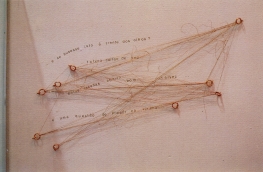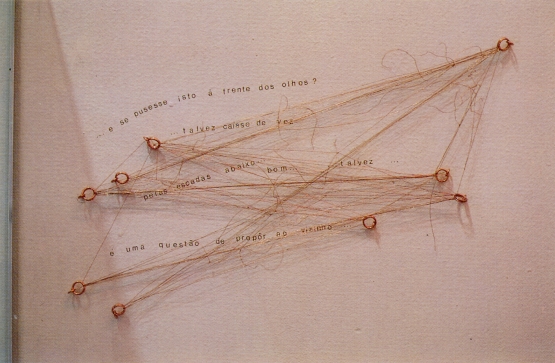
Rosa Almeida - Honni soit qui mal y pense
© DGPC/MNAC
Multipurpose
entry: General ConditionsHonni Soit Qui Mal Y Pense
Rosa Almeida
1996-04-30
1996-06-30
Curatorship: Pedro Lapa
THE MUSEUM AND ITS DOUBLE
The use of line has always been an important factor in the work of Rosa Almeida, which is perhaps why drawing has largely dominated her exhibitions. However, the questions raised here are, for that very reason, not confined to the two-dimensionality of the genre and, even though still based on it, it is her continual exploration of other related areas, which has defined her work. The movement of a line can be metamorphized - not follow the original plan - a strand of hair entangled with numerous others and equally, as in a recent case, the female body is used as a thematic, or in a tensional relationship which clarifies the distant sound of language.
The small pieces on display in this exhibition define unexpected moments in the intimate, yet prosaic, relationship of the public with works on display in a museum. Webs of copper thread superimposed and dislocated in relation to the words written like grafitti on the walls make a generic model of these works. They are a sign of tension within a place of an itinerary which breaks the discursive thread of an inner monologue on various changing subjects. The nature of the commentaries, presupposes a previous vernacular source, or one alien to the cultural tie which envelops the aesthetic experience, once that presupposes competence which is primarily relational accessibility. The situations here refute understanding which identifies the aesthetic object in its history before it willingingly assumes its own shape. They are the result of a movement which pre-empts the works on display in the museum.
These discursive simulations inscribed on the walls of the gallery exchange the omniscient oscillation of the inner voice for the anonymity of a third person, seeking a hyper-real dimension which withdraws from subjective and expressive confessionalism and, though this does not always occur, makes it possible to turn the absurdity of the circumstance against itself. They are condemned to the gratuitous and the ephemeral of the innermost feelings of a solitary passer-by. Their characteristics outline what Marc Augé called the non-lieu, "no-place". The relationship which is established between individuals and museum space - hypothetical or duplicated in these pieces - is one of solitary contractibility which, on the one hand, frees them from habitual conditionalisms and offers another spectacle where everything has lost identity and history. On the other hand, the need to view works compulsively restores the residual of the subject without freeing it from its singular identity, as would presumably occur in so-called "non-places". In these pieces by Rosa Almeida it is in the very ambiguity of this situation that the museum is viewed.
There is a gravity in artistic works which is an obstacle to the mutability of identity created by the leisure spaces characteristic of post-modern societies and a division is required, relational order as resistence. The presence of the threads of copper, similar to the webs woven around discursive situations, may well be a metaphor, nevertheless, the caricature-like semantics of the inscriptions outline a narcissism which is no less compromising. The conceptual tradition encounters everyday discourse and also pre-empts it and returns it to the image condition.
Pedro Lapa
On Exhibition
Mily Possoz. A poetics of space
2025-10-01
2026-02-01
Curatorship: Emília Ferreira
The exhibition “Mily Possoz. A Poetics of Space” continues the research into the lesser-studied Portuguese modernists artists present in the collections of the MNAC and Millennium bcp.
Impressões Digitais. MNAC Collection
2024-12-12
2026-12-30
Curatorship: Ana Guimarães, Emília Ferreira, Maria de Aires Silveira e Tiago Beirão Veiga
Consisting of founding works of contemporary Portuguese art historiography, from 1850 to the present day, the MNAC's collection holds several national treasures.
Since 1911
2022-05-26
2026-05-26
An intervention that celebrates 110 years of the MNAC.










